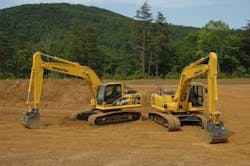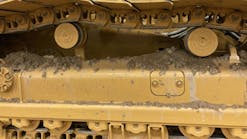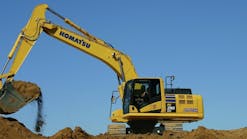“I can look people in the eye and tell them that they’re not giving up anything by having a hybrid—other than not spending as much on fuel. There are no performance drawbacks.”
To put Nájera’s “no performance drawbacks” statement to the test, Construction Equipment editors recently worked with Komatsu America to compare the HB215LC-1 hybrid with the PC200LC-8, running the machines bucket-to-bucket in a series of tests, including trenching and truck-loading, as well as a “multiple-application” evaluation developed by Komatsu’s testing unit. Each test allowed us to compare the two machines’ potential production capacity and their fuel efficiency (work done per gallon of fuel).
The HB215LC-1 and the PC200LC-8 are structurally similar, using the same undercarriage, cab, boom, digging arms and buckets. For our evaluation, both were fitted with an 18-foot 8-inch boom, 9-foot 7-inch digging arm, and 42-inch-wide bucket having a heaped rating (SAE) of 1.34 cubic yards. We conducted the evaluation during the third week of May at Komatsu’s training facility in Cartersville, Ga., where the machines worked in a mostly clay material weighing an estimated 2,850 pounds per cubic yard.
Our operator for the evaluation was Russ Peters, a principal in Red’s Excavating, a firm based in Green Bay, Wis., and specializing in all types of grading and excavating, as well as installation of sewer and water laterals. Peters’ firm owns five Komatsu excavators, including two PC200LCs and an HB215LC-1. The company was among the first excavator-using contractors that Komatsu asked to evaluate the initial hybrids brought to North America in fall 2009. Based on the hybrid’s performance, Peters subsequently made a rental-purchase agreement on an HB215LC-1, which currently remains in his fleet.
Peters admits he’s the kind of operator who continually refines his technique to get the best from any machine—and that he has taken a special interest in the hybrid.
“I have almost two seasons tweaking operation on the hybrid,” says Peters, “and I’ve found that making a few simple changes in technique, compared to the PC200, makes a positive difference in performance.”
EDITOR’S NOTE: Komatsu emphasizes that the HB215LC-1 is designed to be the PC200LC-8’s equal in regard to production capacity, and, subsequently, the company’s marketing approach makes only the claim that the hybrid will use less fuel than its conventional counterpart. Respecting Komatsu’s marketing strategy, Construction Equipment has chosen not to publish exact numbers resulting from production studies between the two machines during testing. We do report, however, which machine was more productive in each test event and why we found it to be so.
Hybrid history
According to Nájera, Komatsu’s first hybrid excavator, the PC200LC-8 Hybrid, was introduced mid-2008 in Japan. The machine gained rapid popularity in Far Eastern markets, he says, and the current hybrid population worldwide numbers some 700 units. When Komatsu brought 10 hybrids to North America in late 2009, the company placed them in varied applications across the United States and Canada, including EPA nonattainment areas.
“At that time,” says Nájera, “the overall market for machines was down and fuel prices were relatively low—probably not the best time to introduce a hybrid with a price premium.”
An initial sales obstacle in North America, says Nájera, was that potential buyers compared the machine to hybrid cars, voicing concerns that the machine would not only cost more initially, but also would require expensive maintenance, such as replacing a pricey battery pack.
“We had a challenge explaining that the hybrid uses no battery pack, and that the machine is designed as a package to incorporate electrical components that could well outlast conventional components,” he says. “We can now substantiate that claim, because some of the early machines are approaching 14,000 hours of service. Now, with the HB215LC-1, we have an even more refined version of the hybrid concept.”
Hybrid design
The design of the HB215LC-1 is relatively straightforward, using four major electrical components not found in its conventional counterpart: a generator motor, inverter, capacitor and electric swing motor.
The generator motor is placed between the engine and the hydraulic-pump drive and is integrated with the engine flywheel. When serving as a generator, the generator motor sends AC current to the inverter, which converts the AC power to DC and directs it to the capacitor. The capacitor’s job is quick storage of the DC power and rapid release of the power to the swing motor or to the generator motor.
At the heart of Komatsu’s hybrid design is the swing motor’s ability to generate electricity from the energy produced when the motor brakes the upper structure at the end of a swing cycle.
Because braking forces are so great, says Komatsu, the system generates a large amount of electricity, which is sent to the capacitor for storage. The stored energy can be used in two ways: to power the swing motor or to power the generator motor. If power is sent to the latter, then this component now serves as an electric motor to assist the engine in driving the hydraulic pumps.
“The assist of the generator motor can supply as much as 60 horsepower to the force of the engine for driving the pumps,” says Nájera. “That’s why the hybrid is so responsive to hydraulic demand. Plus, using electricity to accelerate the engine saves significant fuel.”
Electric engine assist allows Komatsu to use a smaller engine in the hybrid. The HB215LC-1 uses a four-cylinder, 139-horsepower engine, versus the six-cylinder model with 148 horsepower in the PC200LC-8. Although rated horsepower is close, the smaller engine is significantly more fuel-efficient, says Komatsu.
Controlling the overall functioning of the hybrid system is electronic intelligence that makes decisions about how the system’s electrical power is best used in the machine’s activities—whether the generator motor assists the engine or charges the capacitor, and whether the capacitor sends power to the swing motor or to the generator motor to assist engine acceleration.
Low-speed matching
Komatsu has taken engine efficiency in the HB215LC-1 a step further with its “low-speed-matching” system. First, as Nájera explains the system, the hybrid’s engine idles at 700 rpm, significantly below that of the PC200LC-8’s engine and another plus for fuel conservation. But the system’s primary benefit, he says, is its ability to constantly adjust engine speed to the machine’s load.
“Instead of running the engine constantly at high idle and allowing it to lug down to peak-torque speed when the load increases,” says Nájera, “the hybrid’s engine basically starts at low idle and ramps up as needed. There’s efficiency in having an engine run at constant speed, of course, but the low-speed-matching system in the hybrid improves on that benefit.”
If you stand next to the HB215LC-1 when it’s working, you hear the engine varying its speed. But since the engine runs at the lowest speed necessary, the machine gives the impression that it’s significantly quieter than the PC200LC-8. According to Nájera, some customers have used the hybrid in noise-sensitive areas where its constant-speed counterpart would have been noticeably louder.
“But the different sound of the engine can work against the hybrid,” he says, “because some operators, if they don’t hear the engine lugging down, conclude that the machine lacks power. You can’t just hand the keys to an operator unfamiliar with the hybrid and turn him loose.You have to explain how the system works and tell him to focus on stick and bucket movement, not engine sound.”
Peters agrees: “I’d say you need a week to get acclimated to the hybrid. We have a veteran operator who wasn’t a fan of the hybrid, because he thought it didn’t have the power of the PC200. But I encouraged him to stick with it, and it came as somewhat of a revelation one day when he realized that the hybrid was getting an extra day between fueling and that he was getting through his work a half-day sooner on some projects.”
Multiple-application evaluation
In the multiple-application evaluation, the machines sequentially loaded a truck, opened a trench, dug a drainage ditch, and spread loose material, completing 10 cycles in each event. They then traveled for a given time (1.25 minutes) and, finally, idled for a set time (5 minutes). The objective was to simulate “a day in the life of a 20-ton excavator” as a means of checking relative production capacity and fuel efficiency. Each machine ran the circuit twice, and we collected a total elapsed time for each run, as well as times for the individual events.
To assure ourselves that both machines took essentially the same amount of time maneuvering between events, we backed out the known times for the six events from each machine’s total elapsed time. The remainder was repositioning time, which was, indeed, nearly equal, with an average difference of only 15 seconds between the two machines in each run.
The net results of this exercise were twofold: first, we could compare the working speeds of the machines as they completed their various dirt-moving tasks, thus giving an indication of their relative production capacities; second, by using fuel-consumption data reported from the machines’ monitor panels, we had the information to compare fuel efficiency.
According to Komatsu, the monitor’s electronic intelligence has the capability to analyze fuel consumption based on a machine’s activity in a specified time period and to report a projected gallons-per-hour rate.
For example, although the actual fuel-consumption rate would have been different for each specific activity in the multiple-application evaluation (ranging from a high for traveling to a low for idling), the system’s logic, says Komatsu, can report an average hourly consumption rate for the mix of activities, assuming that the system was reset to zero at the beginning of the evaluation.
For the multiple-application evaluation, we reasoned that since both machines did essentially the same amount of work, then comparing fuel used would provide an insight into fuel efficiency. A thumbnail summary of the data showed the HB215LC-1 to be 21 percent more fuel efficient (performing the same amount of work as the PC200LC-8, but using 21 percent less fuel). Projected fuel savings in this instance amounted to about one gallon per hour. In addition, the hybrid showed a significant advantage in working speed, which could translate into added production.
Truck-loading evaluation
For the truck-loading evaluation, Peters used each machine to 10-pass load a tandem-axle dump truck multiple times. He dug material from a shallow trench, swung 90 degrees, and dumped into the truck. We timed each 10-pass loading sequence, then weighed the truck to determine payload. The machines were shut down between loads in order to eliminate idling from the fuel calculation.
To summarize, we found the HB215LC-1 to be slightly more productive, the result of a faster average cycle time and a slight edge in average bucket fill (amount of material loaded per bucket). We again determined fuel consumption by using the monitor’s fuel-reporting system, which told us, essentially, that if the machines loaded trucks nonstop for an hour (a 100-percent duty cycle), they would use the reported gallons of fuel. When we calculated fuel efficiency for each machine (tons moved per gallon of fuel), the hybrid was again the standout with an advantage of 33 percent.
Trenching evaluation
For the trenching evaluation, Peters opened two trenches with each machine, digging for 20 minutes per trench and opening a total of more than 250 linear feet. Target depth was 10 feet and width was a bucket wide. We measured trench depth and width at three-foot increments, and when calculating the volume excavated, we compensated for the flare in width at the top of the trenches.
As in the truck-loading evaluation, the monitor’s fuel-consumption system gave a per-hour estimate for fuel used. By projecting an average per-hour production rate for each unit, then dividing by the reported fuel number, we determined that the hybrid’s fuel efficiency (cubic yards moved per gallon of fuel) averaged 33 percent better than that of its conventional counterpart. The test also indicated that the hybrid has the potential to be significantly more productive at this task, because, based on test results, it exhibited a faster average cycle speed.
Summing up
Taking the long view of test results, the most significant numbers were those for the hybrid’s fuel efficiency advantage, averaging right at a third better (33 percent) for both the trenching and truck-loading evaluations. Add the multiple-application calculation for fuel efficiency, and the overall average is still an impressive 29 percent.
Our testing indicates that the hybrid also has the potential to be more productive than its conventional counterpart, and that its potential productivity advantage is the result, essentially, of its faster average cycle time. Seems to us that the hybrid’s fuel efficiency and potential productivity gains are proportional to the swing-intensity of the operation.
“In my experience,” says Peters, “the hybrid always burns much less fuel and typically out-produces the conventional machine in moderate to heavy applications. In really severe applications, I’d say that performance between the two is about equal, but the fuel savings are still there for the hybrid. For me, the hybrid makes sense, and it’s great for public image.”
Peters also is willing to accept the price premium that the hybrid commands. In his operation, he says, the hybrid’s benefits outweigh the higher purchase price. He’s quick to qualify his experience, however, by saying that not all contractors will find the hybrid’s benefits of value on their specific jobsites. Like all machine acquisitions, says Peters, buyers must think through all the cost/benefit considerations.





